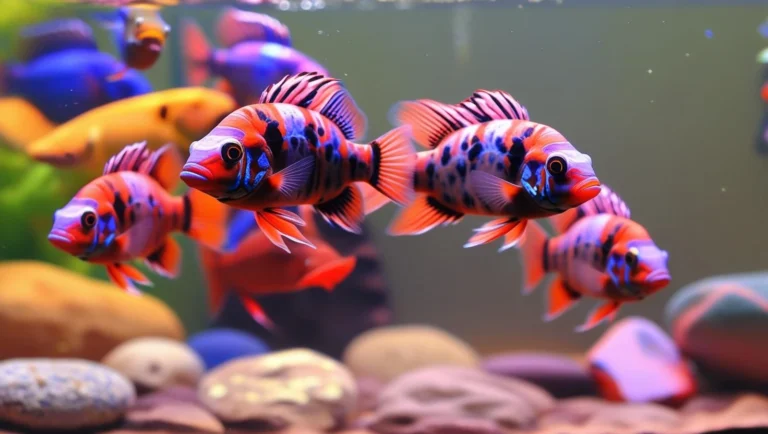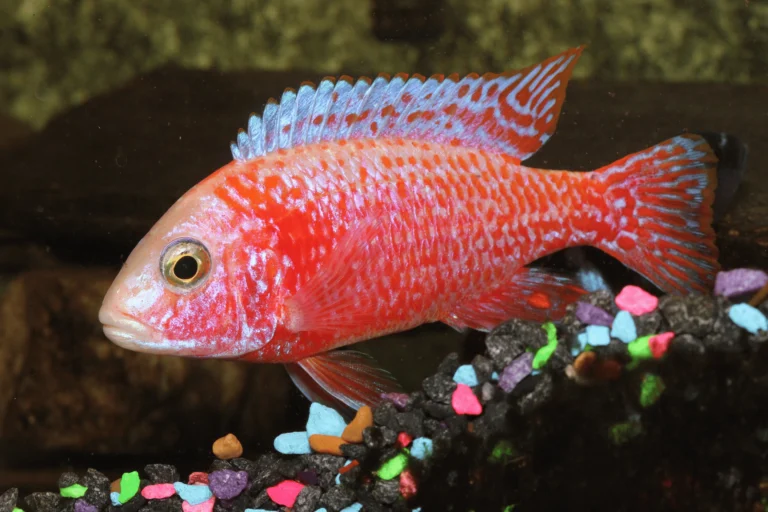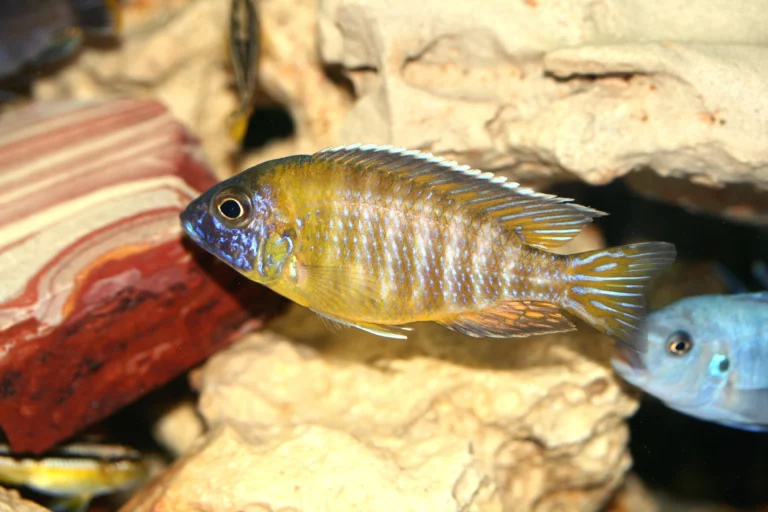Your trusted guide to cichlid care, tank setups, and quality products.

Top 7 Peacock Cichlid Myths: Shocking Truths Revealed
Separating fact from fiction in the world of peacock cichlids! Our guide debunks 5 common myths, providing accurate information and dispelling misconceptions about these fascinating fish.
Image credits Canva
Peacock Cichlids are among the most vibrant and captivating freshwater fish, cherished by aquarists around the globe. However, misinformation has given rise to various misconceptions about their care, behavior, and requirements. These common Peacock Cichlid myths can create confusion for both novice and experienced hobbyists. In this comprehensive guide, we aim to debunk the most common Peacock Cichlid myths, revealing essential truths to help you provide optimal care for these stunning Peacock Cichlid fish. Let’s dive into the fascinating world of Peacock Cichlid myths and uncover surprising facts every aquarist needs to know about Peacock Cichlid myths.
At PeacockCichlid.com, we believe in transparency and honesty with our readers. Some of the links in this article are affiliate links, which means we may earn a small commission if you make a purchase through them—at no additional cost to you. These commissions help support our site, allowing us to continue providing expert advice, in-depth guides, and valuable content for Peacock Cichlid enthusiasts like you.
We only recommend products that we trust and believe will be beneficial for your aquarium. Thank you for your support!
Peacock Cichlid Myths #1: Peacock Cichlids Are Always Aggressive
One of the most widespread misconceptions is that Peacock Cichlids are inherently aggressive and unsuitable for peaceful aquariums. This common Peacock Cichlid myth paints an inaccurate picture of their temperament and often deters hobbyists from considering these beautiful fish.
Truth: Peacock Cichlids Are Generally Peaceful
Compared to their relatives, such as the highly territorial Mbuna cichlids, Peacock Cichlids are relatively calm. Aggression typically arises only under specific circumstances, such as overcrowding, breeding, or poor water conditions.
Tips to Reduce Aggression:
- Tank Size: Choose a 55-75 gallon tank to give your Peacock Cichlids ample space to establish territories and avoid conflicts.
- Male-to-Female Ratio: Maintain a ratio with more females than males to reduce competition among males.
- Hiding Spots: Include plenty of caves, rocks, and aquatic plants for shelter and privacy.
- Bonus Tip: Rearrange the tank layout occasionally to disrupt territorial patterns and promote harmony among Peacock Cichlids.
By implementing these strategies, you can create a peaceful and thriving environment for your Peacock Cichlids, effectively dispelling this common Peacock Cichlid myth. Understanding this aspect of Peacock Cichlid myths is key to successful fishkeeping.
Peacock Cichlid Myths #2: Peacock Cichlids Need Giant Tanks
Another prevalent misconception is that Peacock Cichlids require massive tanks to thrive. Let’s explore the truth behind this Peacock Cichlid myth and understand their actual space requirements.
Truth: Balanced Tank Setup Matters More Than Size
While a spacious tank is beneficial, it’s not about sheer size but rather balance and proper management. A well-maintained 55-75 gallon tank is sufficient for small groups of Peacock Cichlids.
Tips for an Ideal Tank Setup:
- Filtration: Use a high-quality filter to keep the water clean, clear, and healthy for your Peacock Cichlids.
- Aquascaping: Add rocks, caves, and plants to define territories and reduce stress among your Peacock Cichlids.
- Avoid Overcrowding: Ensure enough swimming space for each Peacock Cichlid by maintaining appropriate stocking levels.
- Bonus Insight: Sand substrates are ideal as Peacock Cichlids enjoy sifting through them. Gentle lighting can also mimic their natural environment, enhancing their comfort and well-being.
Focusing on quality over sheer size ensures a thriving habitat for your Peacock Cichlids, debunking this Peacock Cichlid myth and addressing common Peacock Cichlid myths about tank requirements.
Peacock Cichlid Myths #3: Peacock Cichlids Can Survive in Any Water Conditions
Many aquarists mistakenly believe that Peacock Cichlids are adaptable to any water conditions. This Peacock Cichlid myth can lead to neglect of their specific requirements and result in health issues.
Truth: Peacock Cichlids Require Specific Water Parameters
Peacock Cichlids originate from Lake Malawi, which has unique water conditions. Replicating this environment is crucial for their health and longevity.
Ideal Water Parameters for Peacock Cichlids:
- pH: 7.8-8.6
- Temperature: 76-82°F (24-28°C)
- Hardness: Maintain consistent levels of water hardness to match their natural habitat.
Pro Tips for Water Quality:
- Perform regular water changes to prevent toxin build-up and maintain pristine water conditions for your Peacock Cichlids.
- Use pH buffers to stabilize water chemistry and avoid sudden fluctuations.
- Consider a reverse osmosis (RO) system to maintain water purity and hardness levels.
Meeting these parameters ensures stress-free, vibrant Peacock Cichlids, effectively debunking this Peacock Cichlid myth and highlighting the importance of accurate knowledge about Peacock Cichlid myths regarding water conditions.
Peacock Cichlid Myths #4: Peacock Cichlids Only Eat Live Food
A significant myth is that Peacock Cichlids require an exclusive diet of live food to thrive. This Peacock Cichlid myth overlooks their dietary flexibility and potential for a balanced diet.
Truth: A Varied Diet is Essential for Peacock Cichlids
While Peacock Cichlids enjoy live food on occasion, a balanced diet is key to their health, growth, and vibrant coloration.
Best Diet for Peacock Cichlids:
- Staple Food: High-quality cichlid pellets or flakes that meet their nutritional needs.
- Supplements: Frozen or freeze-dried brine shrimp, bloodworms, or spirulina to enhance their diet.
- Vegetables: Blanched greens like spinach or zucchini for added nutrition and variety.
Feeding Tips for Peacock Cichlids:
- Feed small portions 2-3 times daily to mimic their natural feeding habits.
- Avoid overfeeding by observing their eating behavior and removing uneaten food promptly.
Providing a varied and nutrient-rich diet ensures vibrant colors, robust health, and longevity, debunking this Peacock Cichlid myth and giving you a deeper understanding of Peacock Cichlid myths related to feeding.
Peacock Cichlid Myths #5: Only Male Peacock Cichlids Are Colorful
Another common belief is that only male Peacock Cichlids display striking colors. Let’s explore the reality behind this Peacock Cichlid myth and appreciate the beauty of both genders.
Truth: Female Peacock Cichlids Have Subtle Beauty
While male Peacock Cichlids are more vividly colored, females also exhibit subtle and elegant hues, especially under optimal conditions.
Tips for Enhancing Colors in Peacock Cichlids:
- Keep the tank clean with consistent maintenance and water quality checks.
- Feed color-enhancing foods such as spirulina or specially formulated cichlid pellets.
- Use proper aquarium lighting to highlight the natural beauty and coloration of your Peacock Cichlids.
Fun Fact: During breeding, some female Peacock Cichlids develop enhanced coloration, making them equally fascinating to observe and care for. This dispels yet another of the widespread Peacock Cichlid myths.
Peacock Cichlid Myths #6: Peacock Cichlids Are Difficult to Breed
This myth suggests that breeding Peacock Cichlids is a challenging endeavor. Let’s uncover the truth behind this Peacock Cichlid myth and explore how achievable it can be.
Truth: Breeding Peacock Cichlids is Rewarding and Achievable
With patience and the right conditions, breeding Peacock Cichlids can be straightforward and incredibly rewarding for aquarists.
Breeding Tips for Peacock Cichlids:
- Maintain a water temperature of 78-80°F to encourage spawning behavior.
- Provide caves or flat surfaces for spawning and ensure a calm environment.
- Separate the fry into a dedicated tank to protect them from predators and ensure proper growth.
Watching their courtship displays and raising fry can be a rewarding experience, proving this Peacock Cichlid myth wrong and further debunking Peacock Cichlid myths about breeding challenges.
Peacock Cichlid Myths #7: Peacock Cichlids Are High Maintenance
Lastly, there’s a widespread belief that Peacock Cichlids are challenging to care for. This Peacock Cichlid myth discourages beginners from exploring these beautiful fish.
Truth: Peacock Cichlids Are Beginner-Friendly
With proper knowledge and care, Peacock Cichlids are surprisingly easy to maintain and ideal for beginners looking to add vibrant fish to their aquariums.
Essential Care Tips for Peacock Cichlids:
- Provide a clean tank with efficient filtration and regular water changes.
- Maintain stable water conditions with consistent testing and adjustments.
- Feed a nutrient-rich, balanced diet tailored to their dietary needs.
These straightforward care steps make Peacock Cichlids a joy to own, debunking the myth of high maintenance and showcasing their suitability for all aquarists. This wraps up the common Peacock Cichlid myths.
Conclusion: Understanding Peacock Cichlid Myths for Better Care
Peacock Cichlids are magnificent fish that enrich any aquarium with their vibrant colors and fascinating behaviors. By debunking these Peacock Cichlid myths, aquarists can approach their care with confidence and knowledge. Whether it’s addressing myths about aggression, tank size, water parameters, or diet, understanding the truth behind Peacock Cichlid myths empowers you to create the perfect environment for these stunning creatures.
Embracing the truths behind Peacock Cichlid myths allows you to appreciate their unique qualities and provide the care they truly deserve. With the right information and a commitment to their well-being, your Peacock Cichlids will thrive and reward you with their breathtaking presence. Don’t let Peacock Cichlid myths hold you back—dive into the rewarding world of these amazing fish and experience the joy of keeping them healthy and happy!
As you continue your journey in uncovering the truths behind common peacock cichlid myths, why not explore more expert advice to elevate your aquarium care? For instance, our “Breeding Peacock Cichlids: 5 Proven Tips for Massive Success” delves deeper into advanced breeding techniques, while “10 Proven Tips to Master Peacock Cichlid Diet and Breeding” offers essential guidance on nutrition and reproduction. If you’re just beginning your adventure, our “Peacock Cichlid Care: 7 Powerful Tips for Beginners” provides a solid foundation, and “Peacock Cichlid Compatibility: 5 Proven Tips for Success” can help you maintain a harmonious community tank.
We’re always updating our resources with fresh insights and expert tips, so be sure to visit peacochcichlid.com again and follow our social media channels for the latest updates and community news. Happy fish keeping!
FAQ’s
Are Peacock Cichlids aggressive fish?
Peacock Cichlids are generally peaceful compared to other African cichlids. Aggression arises mainly from overcrowding or during breeding.
Do Peacock Cichlids require a massive tank to thrive?
No, a balanced 55-75 gallon tank with proper filtration and aquascaping is sufficient for small groups of Peacock Cichlids.
Can Peacock Cichlids survive in any water conditions?
No, they need specific water parameters like a pH of 7.8-8.6, temperatures between 76-82°F, and hard, alkaline water to thrive.
Is it true that Peacock Cichlids only eat live food?
No, they thrive on a varied diet that includes high-quality pellets, frozen foods, and occasional blanched vegetables.
Are only male Peacock Cichlids colourful?
While males are more vibrant, females can display subtle colours, especially under optimal conditions.
Is breeding Peacock Cichlids difficult?
Breeding is straightforward if you maintain proper water conditions, provide spawning sites, and separate the fry when needed.
Are Peacock Cichlids high-maintenance fish?
No, they are beginner-friendly when given proper care, stable water parameters, and a balanced diet.
How can I reduce aggression in my Peacock Cichlid tank?
Ensure sufficient tank space, maintain a good male-to-female ratio, and include plenty of hiding spots like caves and rocks.
What type of tank setup is ideal for Peacock Cichlids?
A tank with a sandy substrate, rocks for hiding, and clean, alkaline water maintained with proper filtration is ideal.
How do I enhance the colours of my Peacock Cichlids?
Feed them a nutrient-rich, colour-enhancing diet, maintain clean water conditions, and use proper aquarium lighting.



